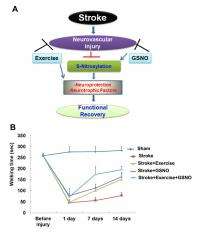Therapy combining exercise and neuroprotective agent shows promise for stroke victims

In a study published in the current issue of Restorative Neurology and Neuroscience scientists report that a therapy combining exercise with the neurovascular protective agent S-nitrosoglutathione (GSNO) improved recovery from stroke in a rat model. GSNO is a compound found naturally in the body and it has no known side effects or toxicity.
"In our study, GSNO or motor exercise provided neuroprotection, reduced neuronal cell death, maintained tissue structure, and aided functional recovery by stimulating the expression of neuronal repair mediators," says lead investigator Avtar K. Singh, MD, of the Medical University of South Carolina (MUSC) and the Ralph H. Johnson VA Medical Center, Charleston. "GSNO in combination with exercise accelerated the rate and enhanced the degree of recovery."
Stroke is both an acute disease and a chronic condition. While the acute phase is associated with cell death and secondary injury, the chronic phase is characterized by insufficient neurorepair mechanisms. Most monotherapies fail because the drugs are not effective in the chronic phase. Rehabilitation has been used to improve neurofunction in the chronic phase, but its efficacy is slow and limited. An ideal therapy would ameliorate the injury in both phases and therefore include a combination of rehabilitation and an agent that provides both neuroprotection and repair, such as GSNO.
Dr. Singh and her colleagues from MUSC (Drs. Mushfiquddin Khan, Harutoshi Sakakima and Inderjit Singh) induced stroke in rats, which were then assigned to one of five treatment groups. The first group received no treatment; the second group was treated with exercise; the third group with GSNO; the fourth group received both exercise and GSNO treatment; and the fifth group received a sham treatment. In the exercise treatment, rats were required to run on a rotating rod motor unit at a constant speed for 20 minutes a day. GSNO was administered throughout the treatment period.
Animals in each group were evaluated for neurological function, motor behavior, and locomotor function before and after the procedure. The size of the infarct was measured. At 7 and 14 days after stroke was induced, brain tissue samples were removed and tested.
Administration of GSNO not only reduced brain injury but also improved neurological scores. Exercise alone could not significantly reduce infarct volume, because the exercise started 72 hours post procedure and infarctions occur before then. However, exercise did improve neurobehavioral functions. Combining the therapies had a synergistic effect, and provided greater functional improvement than either GSNO or exercise alone.
Analysis of the brain tissue found that GSNO accelerates the recovery of neurological and motor functions and enhances the benefit of exercise by stimulating the expression of neurotrophic factor BDNF and its receptors, which play critical roles in neurorepair processes, and by activating Akt, a protein involved in cell proliferation. Dr. Singh and her collaborators Drs. Mushfiquddin Khan and Inderjit Singh conclude, "GSNO is an attractive candidate to be investigated in humans for neurorepair and rehabilitation following stroke."
More information: “Stimulation of functional recovery via the mechanisms of neurorepair by S-nitrosoglutathione and motor exercise in a rat model of transient cerebral ischemia and reperfusion,” by H. Sakakima, M. Khan, T.S. Dhammu, A. Shunmugavel, Y. Yoshida, I. Singh, A.K. Singh. Restorative Neurology and Neuroscience, 30: 5 (September 2012). DOI: 10.3233/RNN-2012-110209. Published by IOS Press online ahead of issue.












